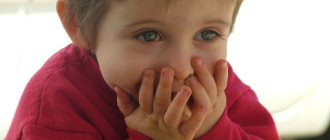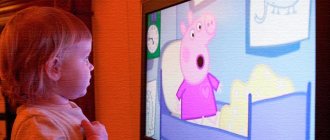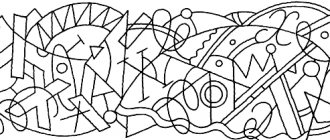The state of general speech underdevelopment (GSD) is characterized by a violation of all aspects of the formation of speech skills.
Its main distinguishing feature is the presence of problems both with the sound side (pronunciation), and with lexical and grammatical aspects. At the same time, children with general speech underdevelopment do not have hearing or intellectual impairments. Distinctive features of OHP:
- The presence of problems both with the pronunciation of sounds and with the skills of coherent expressive speech, mastering the rules of grammatical structure and a poor active vocabulary.
- Hearing is not impaired. A specialist check is required.
- Primary intelligence is normal. That is, a child at birth does not have a diagnosis of “mental retardation,” etc. However, it is worth keeping in mind that long-term uncorrected mental retardation can also lead to mental retardation.
It is possible to talk about the presence of general speech underdevelopment in a child only after 3-4 years. Until this time, children develop differently and “have the right” to some deviations from average norms. Everyone has their own pace of speech formation. But after 3, it’s worth paying attention to how the child speaks. It is quite possible that he needs the help of a speech therapist.
The manifestation of OHP in children is expressed differently based on their depth of impairment.
Four levels of OHP
General speech underdevelopment occurs in 40% of preschool children. Speech therapists distinguish four levels of speech development:
- Level 1 – characterized by a complete absence of coherent speech. In the medical field, this condition is called “speechless children.” Babies communicate using simplified speech or babble, and also actively gesture;
- Level 2 – the initial development of general speech is observed, but the vocabulary remains poor, and the child makes a large number of mistakes when pronouncing words. In such cases, the maximum that a child can do is utter a simple sentence that will consist of no more than three words;
- Level 3 – differs in that children can compose sentences, but the semantic and sound load is not sufficiently developed;
- Level 4 is the mildest stage of the disease. This is explained by the fact that the child speaks quite well, his speech is practically no different from his peers. However, disturbances are observed during pronunciation and construction of long phrases.
Degrees of systemic underdevelopment
Systemic speech underdevelopment has varying levels of severity - from minor deficiencies of a grammatical, lexical, phonetic-phonemic nature to a complete lack of ability to form long, complex sentences if the systemic speech underdevelopment is severe. There are 3 main degrees of pathology, each of which has its own characteristic features.
Mild SNR
Characterized by the following manifestations:
- There is mild dysgraphia;
- Sound pronunciation disorders are absent or minor;
- Phonemic perception, phonemic analysis and reproduction in general without defects, difficulties are revealed only when determining the number and sequence of phonemes with complex speech material;
- The vocabulary is not rich relative to age;
- When retelling, the main semantic line is revealed, there are small omissions of minor semantic lines, semantic relationships may be lost;
- In colloquial unprepared speech, minor agrammatisms are identified; special research reveals inaccuracies in the use of complex prepositions;
- Violations of complex forms of word formation, violations of the agreement of adjective and noun in indirect plural cases.
Moderate SNR
Characterized by the following manifestations:
- The pronunciation of only one group of sounds is impaired;
- Underdevelopment of phonemic hearing and phonemic analysis (depending on the complexity of the speech material, the difficulties of phonemic analysis increase);
- Agrammatisms manifest themselves in complicated types of inflection (coordination of genders and cases). The child does not understand and does not use various forms of gender, case and form, and cannot use complex words that are present in his everyday life. The baby can call all the elements of one item by its full name - for example, he calls a pocket, collar, sleeve and button “jacket”.
Severe SUD
Characterized by the following manifestations:
- Two or more groups of sounds are disturbed at the same time, for example, hissing and voiced or whistling, sonorant and voiced.;
- Lack of word formation;
- With a small amount of passive vocabulary, the child tries to name several objects or phenomena with one sound;
- Severe underdevelopment of phonemic perception and phonemic analysis and reproduction (both complex and simple forms);
- Severe problems with the formation and perception of sentences, manifested in violations of both complex and simple forms of inflection and word formation (incorrect use of forms, numbers and cases of words);
- Severe speech perception impairment;
- Lack of coherent speech or its severe underdevelopment.
Symptoms
Children with ODD speak their first words late. Usually by three or four years, sometimes by five. Speech is rarely used, sounds are pronounced incorrectly and phrases are constructed incorrectly. Others do not understand such a child well.
First level. The child cannot pronounce many sounds. Speaks in babbling words. He complements them with facial expressions and gestures, the meaning of which is difficult to understand outside the situation. Vocabulary is limited to consonances, onomatopoeia and a few words. He cannot speak in phrases and does not understand the meaning of many words.
Second level. The child distorts sounds and replaces them. Along with babbling and gestures, he begins to speak in simple sentences of up to three words. Often uses cases incorrectly and coordinates words. Peers know noticeably more words.
Third level. The child pronounces sounds and syllables, making mistakes mainly in difficult cases. Speaks in detailed phrases, but uses simple sentences, having difficulty constructing and understanding complex ones. Uses all parts of speech, but makes mistakes in prepositions and agreement. Names objects inaccurately, and also makes mistakes in cases and accents.
Fourth level. The child pronounces specific sounds and complex words with errors. The vocabulary is varied, but the child has difficulty understanding rare words, synonyms and proverbs. They have difficulty setting out a logical chain of events. They often miss the main point and get stuck on details and repeat themselves.
Causes of speech underdevelopment
The causes of speech disorders are understood as the impact of internal and external harmful factors or their complex on the body, which determines the specificity of the speech disorder.
Internal factors. Harmful effects during fetal development:
- Mother's health. Diseases suffered during pregnancy, allergies, blood transfusions, toxicosis, incompatibility of fetus and mother by blood, smoking and drinking alcohol during pregnancy, maternal age - both very young and mature, infertility treatment, abortion, complicated childbirth, stress in the family and at work, etc.) and other family members (complicated heredity: diabetes, developmental defects, genetic and mental diseases, etc.;
- Hypoxia. Insufficient oxygen supply. With placental insufficiency and during childbirth, the maturation of brain structures is disrupted in the fetus.
- Birth injury. Direct mechanical effects on the fetus during childbirth, causing local damage to the fetus and impaired brain function.
External factors. The immediate conditions in which a child grows and develops:
- general physical weakness of the body (asthenia, rickets, metabolic disorders, diseases of internal organs, diseases of the central nervous system (CNS), as well as severe course of any diseases, including colds, and complications after them);
- unfavorable upbringing conditions (lack of an emotionally positive environment, fear, a traumatic situation in the family, long-term separation from loved ones, any neuropsychiatric diseases and injuries);
- disturbances in the speech of surrounding adults (the speech of children develops by imitation: stuttering, impaired speech rate, unclear pronunciation, including exaggerated childish speech - “lisping” can be absorbed by the child);
- lack of verbal communication with a child under one year old (when they do not talk to the child, explaining this by, for example, that he does not understand).
Nature of the defect
The causes of systemic underdevelopment of level 2 speech are divided into physiological and social. Social defects include both direct defects in upbringing - pedagogical neglect, lack of communication, and unfavorable developmental conditions: if the parents are deaf and mute or speak different languages at home.
Physiological reasons are more common. These are pathologies of the structure of the oral cavity and neurological disorders associated with brain damage. Speech delays often result from:
- difficult pregnancy,
- difficult childbirth,
- infections,
- poisonings,
- traumatic brain injuries.
Often, children suffering from stage 2 ODD experience hyperkinesis (tics), impaired coordination of movements, and fine motor skills. Sometimes such patients find it difficult to concentrate on a task and get tired quickly. Insufficiency of auditory-verbal memory and verbal-logical thinking is often encountered. All these disorders not only accompany speech disorders, but also cause them to varying degrees. The NeuroSpectrum Center for Children's Speech Neurology and Rehabilitation provides a comprehensive approach to the correction of speech disorders and other deviations in child development.
Primary speech therapy examination
Let us describe how the initial examination of the OHP is carried out. First, the speech therapist gets acquainted with the notes of the child neurologist and pediatrician. Clarifies the features of the course of early speech development.
Then he diagnoses oral speech and determines the degree of formation of the language system. Studies the state of coherent speech: composing a story from a picture, retelling.
Examines the correctness of word formation, coordination of parts of speech and sentence construction. Determines the vocabulary and ability of children to correctly name objects or phenomena.
Studies the sound side of speech: the structure and motor skills of the speech apparatus, sound pronunciation, syllable structure and sound content of words. Determines abilities for phonemic perception, sound analysis and synthesis. Conducts diagnostics of auditory-verbal memory and other mental processes.
The conclusion helps to determine suitable correction techniques
The result of the examination is a speech therapy report. It reflects the level of speech development and the clinical form of speech disorder.
For example: level 2 OHP in a child with a motor form of alalia.
The diagnosis after “ONR” must necessarily indicate what clinical diagnosis is causing the speech underdevelopment. The conclusion helps determine appropriate corrective techniques.
Speech Disorder Specialists
Speech therapist.
Most speech disorders are a speech therapy problem, which is why speech therapists should be contacted first.
Neurologist
provides medication support to children with cerebral palsy, alalia, dysarthria, etc.
A defectologist is able to significantly “pump up” a child’s brain, develop intelligence and thinking.
An otorhinolaryngologist determines pathologies of the peripheral speech apparatus of a medical nature: hearing loss, cleft palate, adenoid growths, sore throat, etc.
A teacher of the deaf is involved in the development of speech in deaf and hard of hearing children and adults.
Psychologist. Due to shyness or aggressive behavior, the child’s speech is distorted and impoverished. Problems in the family and with peers can cause delayed speech development.
Neuropsychologist (clinical psychologist) - in case of speech disorders (caused by impaired brain function), teaches the child’s brain to function correctly through motor and play exercises.
| Defectology and speech therapy, as well as Neurology services are available in our center. |
OHP correction
Speech therapy work depends on the level of speech development. Thus, the main directions for level 1 OSD are the development of understanding of addressed speech, activation of independent speech activity and non-speech processes: attention, memory and thinking.
With level 1 OHP, attention is paid to the grammatical side of speech, but the task of correct phonetic formatting of the statement is not set.
With OHP level 2, speech activity and understanding of speech, lexical and grammatical means of language, phrasal speech and clarification of sound pronunciation and evocation of missing sounds are developed.
With OHP level 3, they develop coherent speech and improve the lexical and grammatical aspects of speech. Reinforce correct sound pronunciation and phonemic awareness. At this stage, attention is paid to preparing for the acquisition of literacy.
At level 4 OHP, children are taught until they reach the age standard of oral speech necessary for successful schooling. To do this, they improve pronunciation, vocabulary and grammar, and detailed phrasal speech. Develop primary reading and writing skills.
In schools for children with severe speech impairments, they study with severe forms of ODD levels 1-2. Children with level 3 ODD study in special education classes at a regular school. With OHP level 4 - in regular classes.
Diagnosis of OHP group 2
Diagnosis is approached in a comprehensive manner. It is attended by a pediatrician and specialized specialists - an otolaryngologist, a psychiatrist, a neurologist, and a speech therapist.
The pediatrician’s task is to collect anamnesis, assess the patient’s general health, and give referrals to other doctors.
The task of the otolaryngologist is to assess hearing acuity, identify or exclude deafness and other hearing disorders.
The psychiatrist’s task is to assess the patient’s mental health and rule out mental disorders and diseases that are accompanied by speech disorders. These include, for example, autism, mental retardation.
The neurologist’s task is to assess the baby’s neurological status, since most often speech development disorders are associated precisely with damage to the central nervous system and speech centers of the brain. Therefore, the neurologist refers the patient to hardware diagnostics and only after that makes a diagnosis.
The task of a speech pathologist-defectologist is to determine the form and level of speech underdevelopment and draw up a correction program.
If necessary, drug therapy, massage, physiotherapy and speech therapy massage are included. The role of parents is also important - they should also work with their child at home.
In some cases (for example, with rhinolalia), consultation with a maxillofacial surgeon is necessary. Surgery may be required to correct the defect that prevents the baby from speaking.
Diagnosis by a speech therapist
A speech pathologist examines the medical history obtained as a result of examinations by other specialists. Asks parents to provide information about the course of pregnancy and childbirth, the baby’s speech activity, when he began to coo, said the first word - these data are very important for identifying the causes of underdevelopment.
The speech therapist evaluates the baby’s motor skills, especially fine motor skills, since there is a connection between motor and speech development.
Next, he evaluates the little patient’s oral speech - each of its components. This is necessary to determine speech underdevelopment and the degree of understanding of the baby’s native language. He evaluates this according to 4 criteria:
- Connectivity. The speech therapist evaluates how coherently and competently the child speaks, the order of words in sentences, the consistency and logic of presentation. With general underdevelopment of second-level speech, children cannot consistently express their thoughts or tell something. To assess this characteristic of speech, the speech therapist gives the baby a picture that he must describe, or an audio recording that he must retell. Or simply asks questions that the baby must answer;
- Lexico-grammatical processes. It is assessed how much the child understands the plural and singular numbers, cases, synonyms, antonyms, agreements, as well as generalizing categories, shapes, colors, properties. Children with general underdevelopment of speech at the second level have difficulty selecting the right words, use one word to denote several words that are close in meaning, and generally construct phrases with gross errors;
- Syllable structure. Children with speech development group 2 simplify complex words, reduce them to 1 - 2 syllables, and also change syllables in places and skip them;
- Sound pronunciation. In case of II degree OHP, it suffers. Kids can pronounce up to 20 sounds incorrectly - this is almost all groups. They cannot conduct a sound analysis due to phonemic hearing impairments.
Based on the data obtained, the specialist determines the form of speech pathology, the degree of its severity and draws up an individual correction program.






